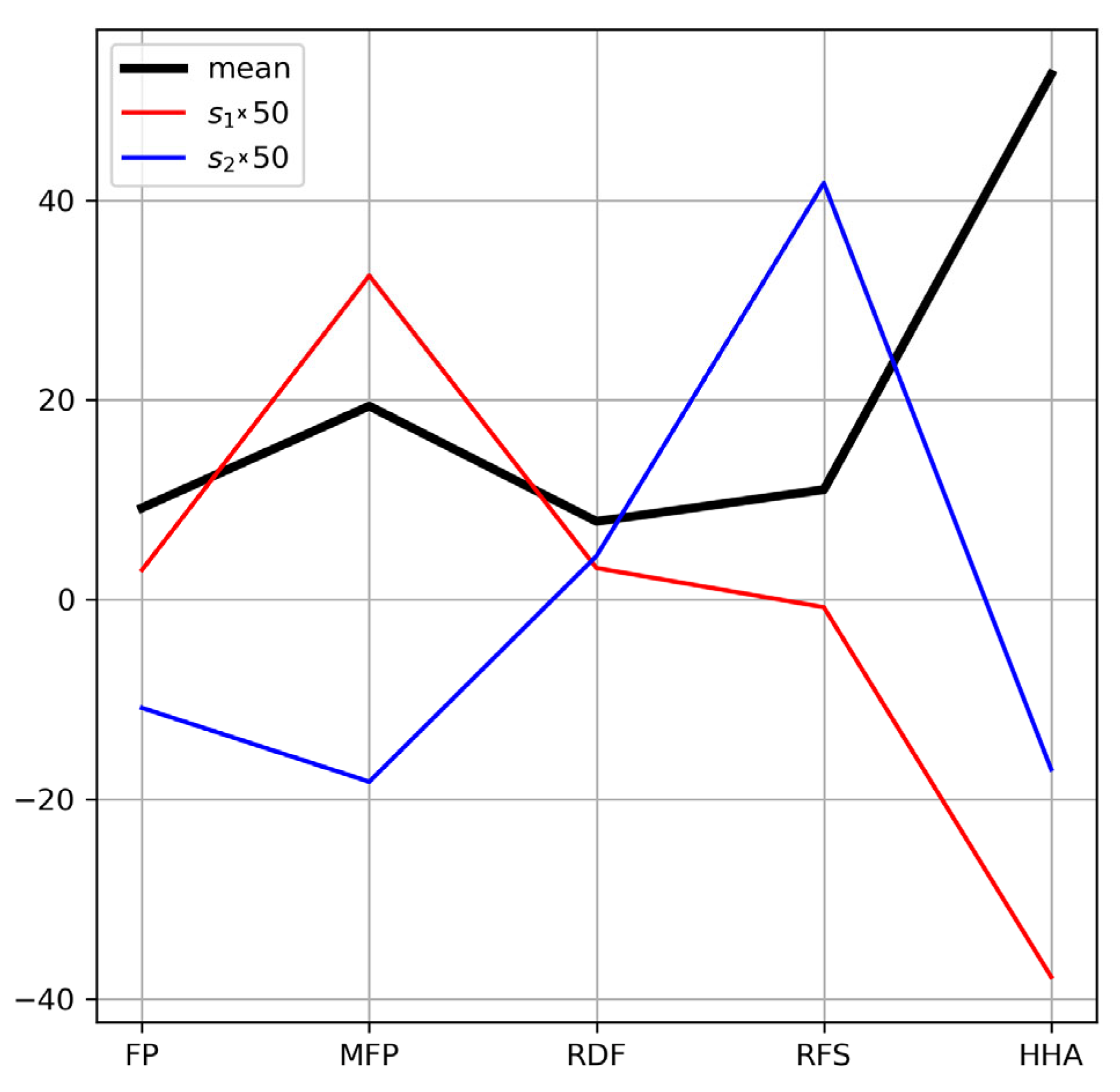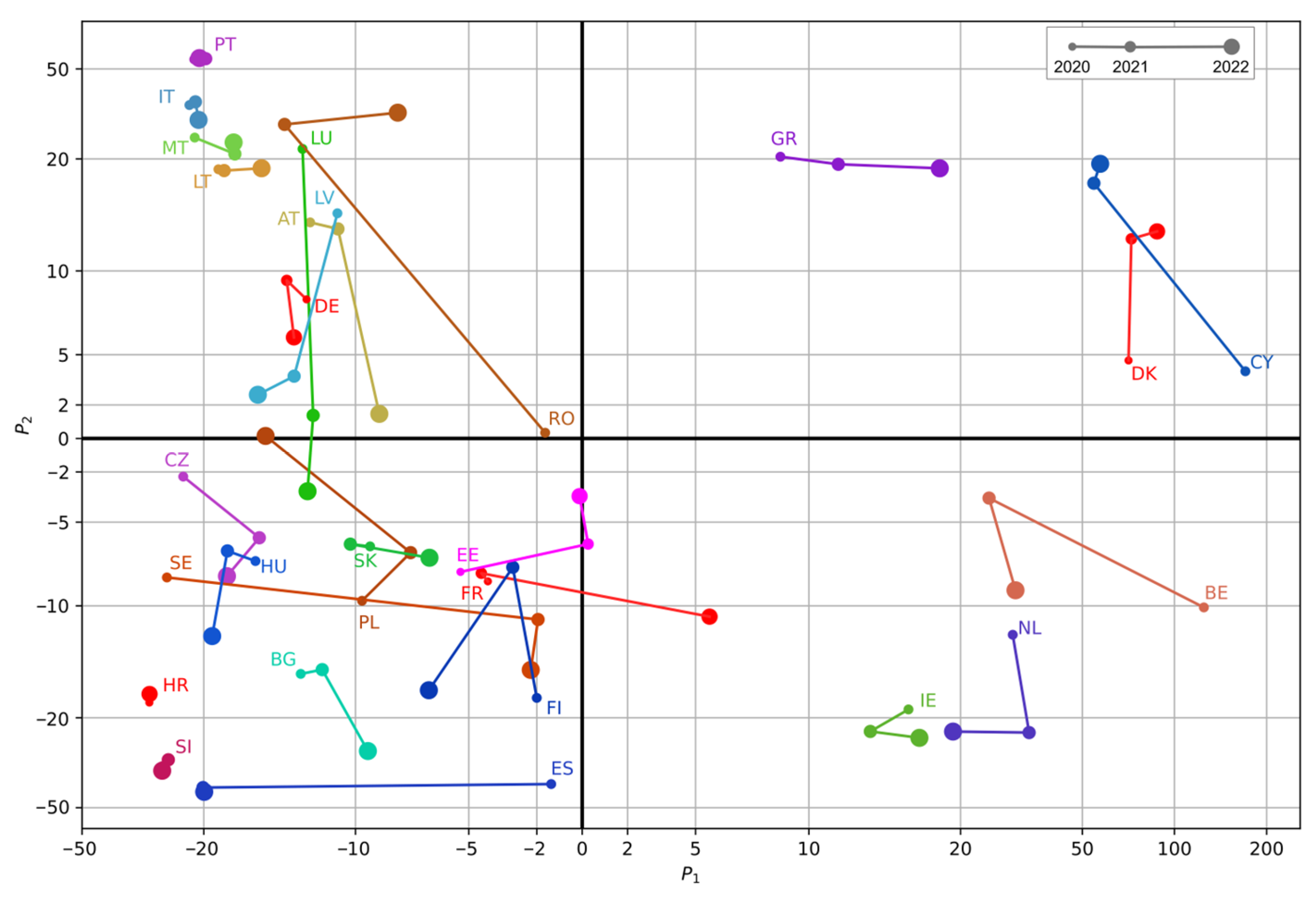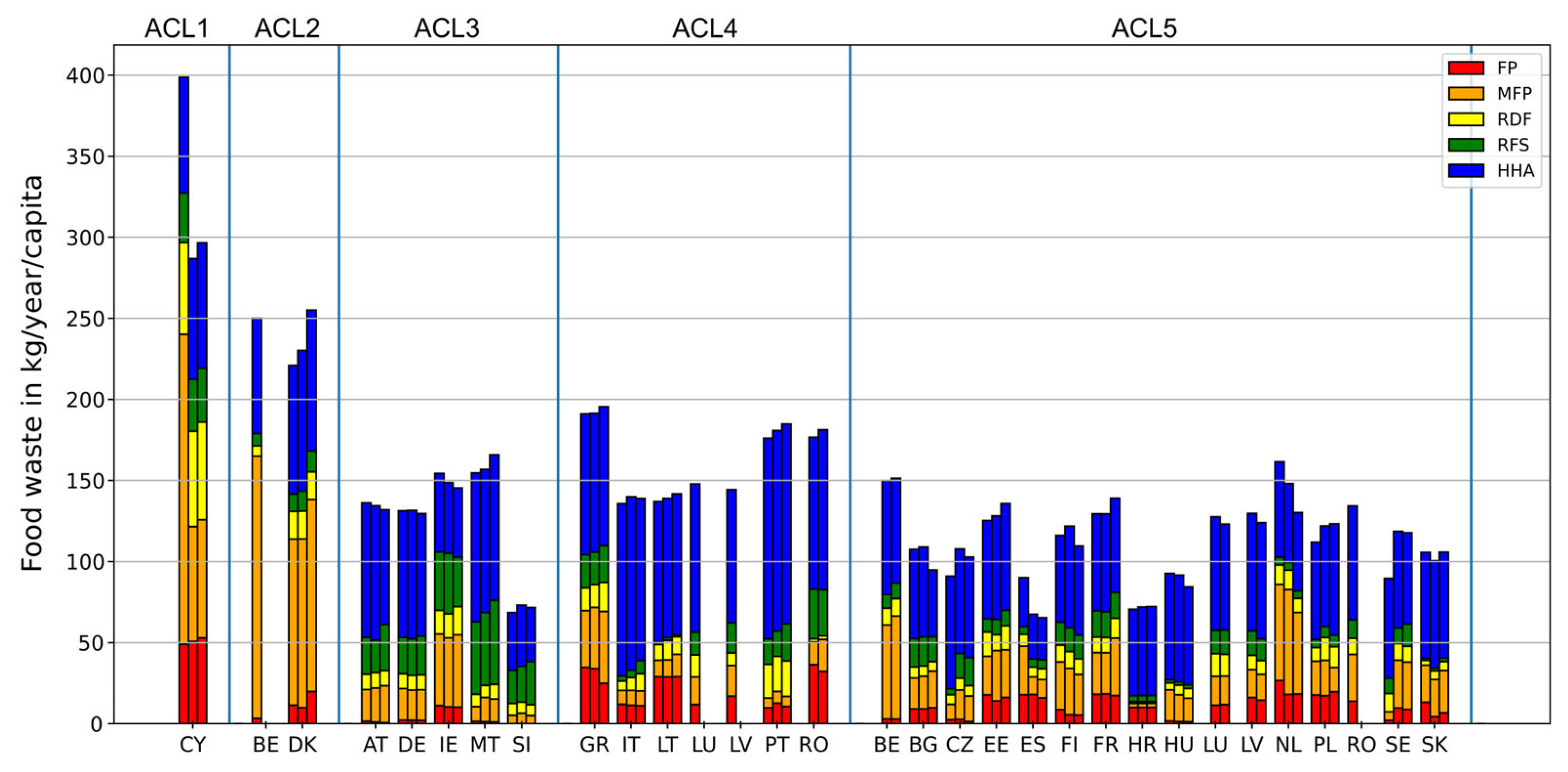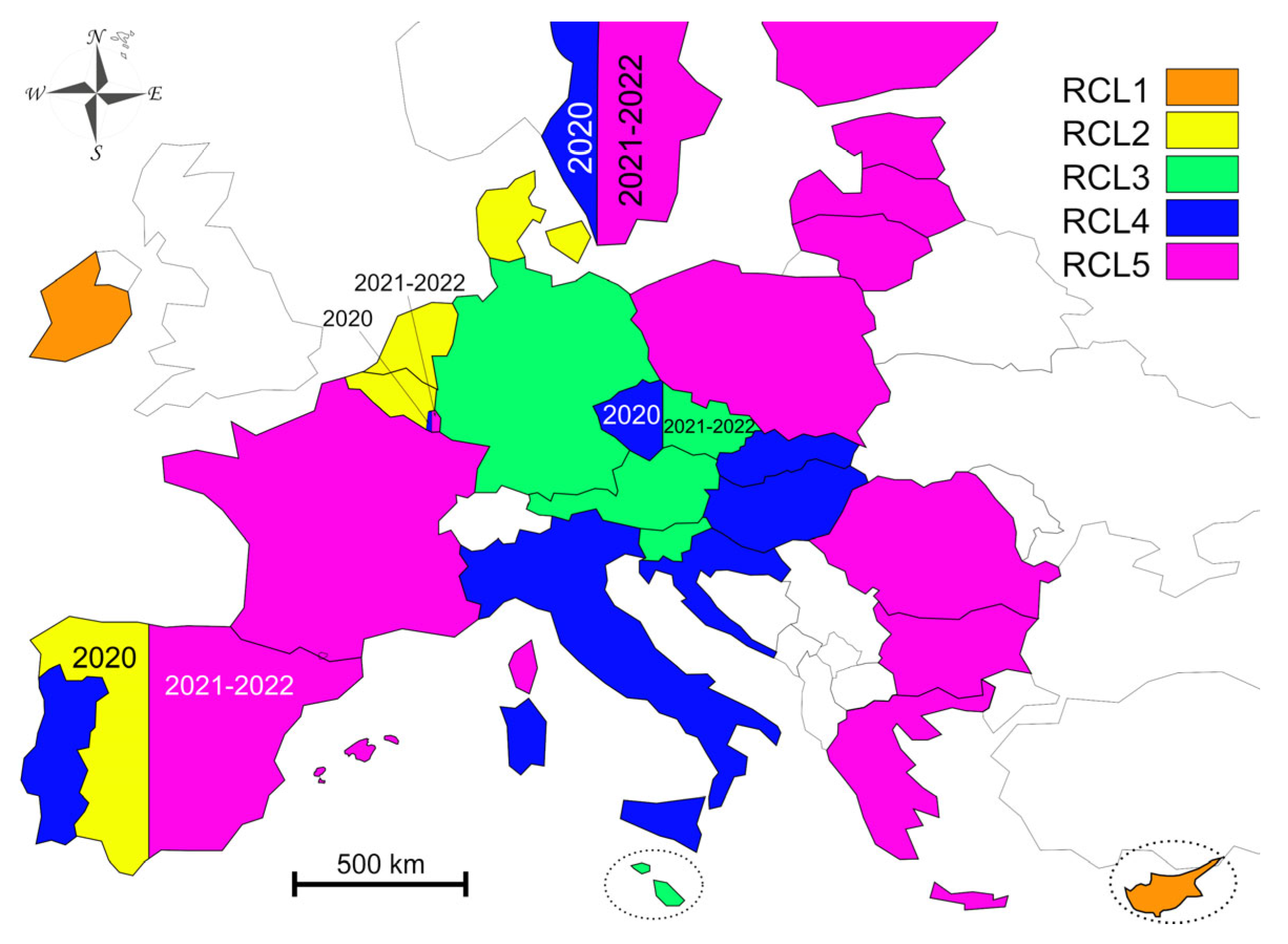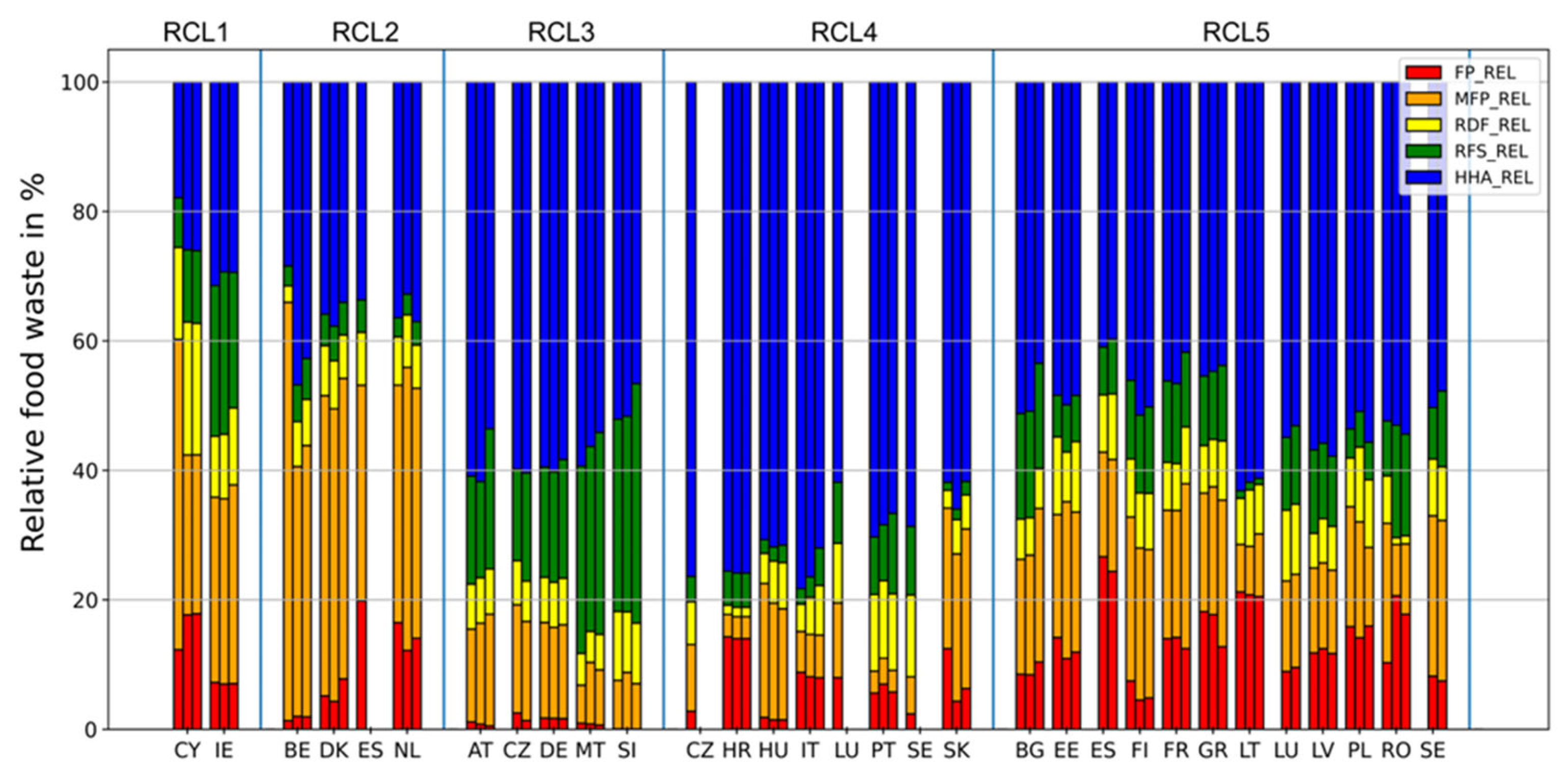Absolute and relative food waste datasets contain five-dimensional vectors for the 27 EU members for the 3 years. One objective of our research was to detect patterns in these datasets. The widely used K-means clustering method was applied to find the groups of similar countries with standard scaling, i.e., applying a linear transformation on the data to obtain a standard deviation of 1 for each component. Without this normalization, changes in the components with the highest average values (HHA and MFP) would dominate the clustering and the effect of the other components would be negligible.
4.3.1. Clusters of Absolute Food Waste Data
Clustering calculations were performed independently for each of the 81 food waste parameter vectors (27 countries for 3 years). Therefore, if the food waste profile of an EU member presents a significant shift during the 3-year period, data from different years for the same country may belong to different clusters.
The next list contains the members of the five clusters. When all three-year data for a specific country are grouped into the same cluster, only the two-letter abbreviation is displayed. Otherwise, the years are appended to the country code. Clusters are denoted by “ACL1”, “ACL2”, …, where “A” indicates that this clustering is based on the absolute food waste parameters.
Figure 3 displays this clusterization on a color-coded map.
ACL1 (1 member): CY.
ACL2 (2 members): BE (2020) and DK.
ACL3 (5 members): AT, DE, IE, MT and SI.
ACL4 (7 members): GR, IT, LT, LU (2020), LV (2020), PT and RO (2021, 2022).
ACL5 (16 members): BE (2021, 2022), BG, CZ, EE, ES, FI, FR, HR, HU, LU (2021, 2022), LV (2021, 2022), NL, PL, RO (2020), SE and SK.
A graphical representation of this clustering is presented in
Figure 4. The columns are sorted to reflect the results of the clusterization, and the blue vertical lines represent the barriers of clusters.
The analysis revealed that most countries preserved their respective cluster affiliations during the examined 3-year period. This indicates that the fundamental characteristics of these countries, as determined by the comprehensive and sectoral distribution of food waste, remained largely stable despite the COVID-19 pandemic. However, Belgium, Latvia, Luxembourg and Romania deviate from this pattern. In all these cases, the data from 2020 were grouped distinctly from the other two years. More specifically, the 2020 data for Luxembourg and Latvia are categorized in cluster ACL4, and for Belgium they are in ACL2, while their data from 2021 and 2022 are in ACL5. Conversely, Romania shifted from ACL5 in 2020 to ACL4 in 2021 and 2022.
Outlier data, such as those observed for Cyprus or Belgium in 2020, can be partly ascribed to methodological idiosyncrasies within specific reporting systems and highlight the need for increased harmonization in food waste data collection.
It is notable that the historical background aligns with the observed clustering patterns. For instance, almost all countries formerly belonging to the Eastern Bloc are in the ACL5 cluster (
Figure 3 and
Figure 4). The prevalence of the former Eastern Bloc nations in the same cluster indicates that previous consumption patterns and economic histories continue to affect present-day food wastage trends.
Table 4 presents the cluster centre values, which serve as multivariate indicators representing the “typical” food waste characteristics of EU members. A yellow background highlights the maximum value in each column. In the line of ACL1, there are three of them, which indicates exceptionally large food waste production in three categories. On the other hand, ACL3 and ACL5 lack any yellow cells, indicating that these clusters comprise countries with low levels of food waste. Households are the primary contributors across all clusters, underscoring that changes in individual consumer habits are key to minimizing food waste in the EU.
The ACL5 nations have the lowest average total food waste quantity, with the lowest amounts of food waste originating from households (HHA), restaurants (RFS), retail and other food distribution channels (RDF). Cyprus, Belgium and Denmark, as members of ACL1 and ACL2, exhibit the highest total food waste levels, the waste being generated particularly in the manufacture of food products and beverages (MFP). The countries in ACL4 are characterized by large amounts of household food waste (HHA), while those in ACL1 and ACL3 experience higher volumes of food waste originating from restaurants and related services (RFS).
4.3.2. Clusters of Relative Food Waste Data
Cluster analysis was also performed on the relative food waste data. The next list presents the members of clusters in text, and in
Figure 5 they are presented in a color-coded map, while
Figure 6 shows the relative food waste parameters in a stacked histogram. The initial letter “R” of the cluster identifiers indicates the relative parameters.
RCL1 (2 members): CY and IE.
RCL2 (4 members): BE, DK, ES (2020) and NL.
RCL3 (5 members): AT, CZ (2021, 2022), DE, MT and SI.
RCL4 (8 members): CZ (2020), HR, HU, IT, LU (2020), PT, SE (2020) and SK.
RCL5 (12 members): BG, EE, ES (2021, 2022), FI, FR, GR, LT, LU (2021, 2022), LV, PL, RO and SE (2021, 2022).
The analysis demonstrates that 23 out of 27 countries maintained their cluster affiliations over the three-year period. This significant stability confirms that the composition of food waste sources remains consistent despite short-term fluctuations. Moreover, similarly to the results of the absolute value-based clustering, the year 2020 is the standout year in all such cases (Spain, Czech Republic, Luxembourg and Sweden).
Table 5 presents the cluster centre values for each cluster, representing the distribution of food waste relative data in different sectors. The maximum values within each column are highlighted with a yellow background. It is remarkable that each cluster features exactly one yellow cell, which means that all five clusters can be characterized by one of the relative food waste parameters. However, for all clusters except RCL1 and RCL2 the majority of waste is generated from household activities. Household food waste (HHA) alone represents 70% of the total in RCL4, showing that in these countries household activities are the dominant source of food waste production. In contrast, manufacture of food and beverages (MFP) makes up the largest portion in RCL2. RCL3 is primarily characterized by a higher proportion of food waste originating from restaurants and food services (RFS) compared to other clusters. Agricultural-origin food waste is almost 14% in RCL5, which is the highest ratio compared to the other clusters. This implies that policy interventions have to be tailored: for instance, restaurant-based interventions for RCL3 and household-based interventions for RCL4 nations.
Clustering results based on absolute and relative food waste parameters differ significantly. This is understandable, considering their distinct approaches to defining “similarity”. The purpose of research should guide the selection of the more relevant method. Absolute unit groups focus on the similarity of average food waste production among individual persons, whereas relative unit groups concentrate on the distribution of a country’s food waste production generated by various sectors. For example, in terms of relative parameters, the food waste profile of Ireland is similar to that of Cyprus, while their absolute values differ significantly. This may indicate that food waste-generating processes have a similar structure in Ireland and Cyprus, but Ireland has a greater degree of economic efficiency overall. The similar behaviour of Ireland and Cyprus in terms of relative values, despite great differences in absolute values, also shows that patterns of food waste can coincide across economies of highly different sizes.
4.3.3. Relationship Between Food Waste Clusters and the Structural Indicators
The structural (environmental, social, economic and geographical) indicators corresponding to the clusters identified in the preceding analysis were gathered, and a statistical analysis was conducted to determine which parameters present significant differences between the clusters. The Mann and Whitney U test was used to compare the distributions. Given the high number of possible relationships examined, strict significance levels were used to minimize the incidence of false-positive signals. Specifically, a p-value threshold of 0.01 was designated for “weak”, and a threshold of 0.001 was designated for “strong” connections. Considering that there are ten possible pairs with the five group (clusters), 10 significance tests were performed per parameter. For the 26 parameters examined, this amounts to a total of 260 tests, meaning that on average there will be 2.6 cases where the test incorrectly indicates a weak correlation and 0.26 cases where a false strong correlation signal will be obtained. These numbers have been verified by trial calculations involving the random dividing of the countries’ annual data into five groups.
The results of the 260 statistical tests are transparently presented in
Table 6 and
Table 7. Columns correspond to cluster pairs, and each row is for a specific structural indicator. The cells are empty if no significant difference was found, but contain “>” or “<” signs for weak differences (0.001 <
p-value <= 0.01) and “>>” or “<<” signs for strong differences (
p-value <= 0.001). The direction of the relational signs indicates whether the first or the second cluster within a pair exhibits higher average values.
Table 6 presents the results for absolute food waste parameters, while
Table 7 shows the results for relative food waste parameters. For instance, in
Table 6 the row corresponding to “GDP_PC” has “>” symbols in the ACL2—ACL4, ACL2—ACL5 and ACL3—ACL5 columns and a “>>” symbol in the ACL3—ACL4 column. This row indicates that the per capita GDPs of cluster 2 and cluster 3 are greater than those of cluster 4 and 5. This suggests a statistical connection between per capita GDP and absolute food waste parameters. However, this is not a simple, monotonic connection. For example, cluster 3 exhibits higher average per capita GDP values compared to cluster 4, yet their total food waste production is approximately the same, with lower average total food waste in the case of cluster 3 compared to cluster 4. The difference between these two clusters can be found in the characteristics of their food waste as represented by the five parameters.
Cluster analysis reveals significant differences in social–economic parameters among the five clusters. The results presented in
Table 6 suggest that food waste levels per person are strongly linked to socio-economic inequalities. The ACL1–ACL5, ACL1–ACL4 and ACL2–ACL4 cluster pairs show the most significant differences in terms of the examined parameters, with distinctions found across 10–11 structural indicators. Additionally, there is a noticeable contrast between the ACL2–ACL5, ACL3–ACL4, ACL3–ACL5 and ACL4–ACL5 clusters in terms of 6–7 distinct indicators.
Countries belonging to ACL2 and ACL3 are richer than countries in ACL4 and ACL5, as they have a higher GDP per capita and a higher purchasing power adjusted GDP per capita. In parallel, they have a higher consumption footprint index (COFP) and higher municipal waste generation (MWG_PC), showing a connection between stronger economies and higher overall waste output (not limited to food).
The poorer countries of ACL4, in contrast, have higher PUKHW (population unable to keep home adequately warm), IAF (inability to afford a meal), RMRPG (at risk of poverty) and RPS_PC (people at risk of poverty or social exclusion) values than the other clusters have, indicating severer social vulnerabilities in the countries in this group.
According to the values, there is no evident relationship between educational status (like ELET and TEA values) and the food waste per capita characterization of a country. The effect of geographical factors (region types) can be observed mainly in the case of Cyprus (ACL1).
The results in
Table 6 indicate that absolute food waste patterns are linked to macro-economic strength and social vulnerability indicators. Wealthier countries, characterized by higher GDP per capita, higher municipal waste and lower deprivation indicators, form a distinct cluster. Conversely, poorer clusters exhibit greater social challenges and relatively lower waste per capita. This suggests that the extent of absolute food waste reflects broader socio-economic inequalities across the EU.
Table 7 compares the cluster results of the analysis performed using relative food waste values (% of total waste per sector). This shifts the focus from how much waste per capita is generated to which sectors dominate food waste in each country. This comparison reveals much greater differences between the individual clusters. The RCL2–RCL4 (15 differences) and RCL2–RCL5 (13 differences) cluster pairs present the most significant differences, but between the RCL1–RCL2, RCL1–RCL3, RCL1–RCL4, RCL1–RCL5 and RCL3–RCL5 cluster pairs there also high dissimilarities (9–11 cases).
Countries belong to RCL1, RCL2 and RCL3 have higher GDP per capita and purchasing power adjusted GDP per capita values than countries in RCL4 and RCL5. This suggests that sectoral distribution of food waste (e.g., manufacturing vs. households) is also influenced by national wealth. Meanwhile, RCL2 and RCL3 demonstrate a higher circular material use rate (CMR) compared to RCL1, RCL4 and RCL5. However, the amount of municipal waste (MWG_PC) is also higher in the countries of RCL2 and RCL3 than those of RCL4 and RCL5.
Significant differences exist in IAF (inability to afford a meal) and RMRPG (relative median at-risk-of-poverty-gap) values, with the best values observed in RCL1 and RCL2 and considerably higher values in RCL4 and RCL5. A significantly higher percentage of people in RCL5 countries face the risk of poverty or social exclusion (RPS_PC) compared to those in RCL2 and RCL3. RCL4 and RCL5 are predominantly characterized by household-level waste (70% in RCL4 and 50% in RCL5), indicating that food waste structure reflects social inequalities.
Tertiary educational attainment (TEA) is strongly connected with relative food waste patterns, with educational status being significantly better in countries within RCL1 and RCL2. People in rural and border regions dominate countries belonging to RCL4 and RCL5 (Eastern and Southern Europe).
To sum up, the results based on relative food waste data highlight structural and sectoral food waste differences. Wealthier clusters (RCL1, RCL2 and RCL3) tend to have higher food waste in manufacturing (RCL1 and RCL2) and restaurant services (RCL3), while in poorer clusters (RCL4 and RCL5) households are the primary source of food waste. This latter pattern may be attributed to weaker redistribution infrastructures, cultural habits and socio-economic vulnerabilities. Geographical context (e.g., rural vs. urban areas) further reinforces these patterns.
As was mentioned above, absolute and relative food waste parameters characterize the food waste production of the countries in different ways. Comparing
Table 6 to
Table 7 shows a significant difference: the former contains 13 strong and 47 weak connections, while in the latter there are 48 strong and 45 weak connections. This indicates that the clusterization based on relative data has a stronger relationship with the structural parameters than that based on absolute data. Uncovering the reason behind this difference can be a topic of further research, but the observation may be important in understanding the connection between food waste production and structural parameters.
